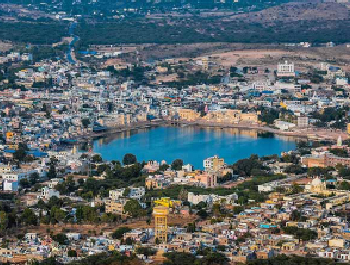
Nestled in the heart of Rajasthan, Ajmer and Pushkar stand as timeless gems, each exuding its unique charm. For a photographer seeking to capture the vibrant tapestry of India, these two destinations offer a captivating blend of history, spirituality, and cultural richness. From the serene shores of Pushkar Lake to the architectural marvels of the Ajmer sightseeing tour, the lens becomes a storyteller, weaving tales of a bygone era and the living traditions that endure.
Pushkar – The Sacred Oasis
Hailed by Hindus as the 'Tirth Raj' or the 'King of Pilgrimage Sites,' Pushkar is critical. The holy Pushkar Lake, the destination's principal draw, draws both devout and photographers. The ghats encircling the lake offer a charming setting, particularly during the yearly Pushkar Camel Fair, when the normally sleepy town is transformed into a rainbow of hues, attire, and camels.
Spirituality in every frame: More than 500 temples dot the town, each with a distinct architectural style and cultural importance. One of the few in the world, the Brahma Temple is devoted to Lord Brahma and gives the photographer's view a spiritual aspect. It becomes a visual feast to capture the colorful ceremonies, decked sadhus, and the mysticism of the Pushkar tour package.
Ajmer – Where History Meets Devotion
With its extensive historical legacy, Ajmer skillfully combines the allure of the ancient world with the vitality of the modern. The Ajmer Sharif Dargah, the last resting place of the Sufi saint Khwaja Moinuddin Chishti, is the city's most famous feature. Offering a plethora of picture options, the Dargah transforms into a melting pot of cultures and emotions.
Architectural Wonders: The Taragarh Fort and the Adhai Din Ka Jhonpra are two examples of Ajmer's architectural marvels. Located atop the Aravalli Range, the Taragarh Fort provides photographers with sweeping vistas of the city and a great angle from which to capture the spirit of the town. The fascinatingly historical Adhai Din Ka Jhonpra mosque is a monument to the development of the city's architectural style.
The Confluence of Cultures –
Ajmer and Pushkar, though distinct in their offerings, share a common thread of cultural diversity. The chaotic lanes of Ajmer resonate with the echoes of Rajasthani folk music, and the markets are a kaleidoscope of colors with traditional handicrafts and textiles. In Pushkar, the fusion of modernity and traditions is evident in the bustling bazaars, where nomadic tribes sell their wares alongside contemporary boutiques.
Capturing Festivals and Celebrations –
The vibrant festivals in Ajmer and Pushkar are a visual spectacle waiting to be enjoyed. Whether it's the exuberant Holi Celebration in Rajasthan or the spiritual fervor during Diwali, photographers can immerse themselves in the vibrant energy that defines these festivals. The annual Pushkar Camel Fair is a cultural extravaganza, offering a unique opportunity to document the nomadic way of life, with thousands of camels converging in a mesmerizing display.
Golden Hour Magic –
Photographers adore the way light dances across the barren plains of Ajmer and Pushkar. The golden tones of sunrise and sunset enchant the surrounding area, bringing out the architectural features and casting a cozy glow over the lakes and forts. Every shot gains depth from the way lighting and shadows interact, turning everyday scenes into remarkable visual stories.
Preserving Heritage through Photography Tour:
Ajmer Pushkar Photography Tour is essential because of its cultural and historical value. By bringing these cities' souls to life and presenting them to a worldwide audience, photographers may help preserve cultural heritage. They can capture through their lens not just the monuments but also the customs, festivals, and day-to-day activities that distinguish these cities from others.
Conclusion –
Ajmer and Pushkar invite photographers to go on an enduring photographic adventure. The way faith, history, and culture interact produces a world of photographic opportunity where each picture tells a tale. The way the lens renders these cities' hues, patterns, and feelings immortalizes the ageless beauty that characterizes Pushkar and Ajmer, transforming them from travel destinations into living works of art for photographers.